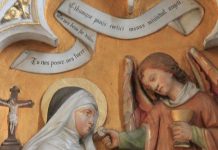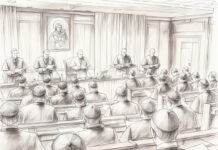The doctrine of papal infallibility was dogmatically defined in the First Vatican Council’s document Pastor Aeternus in 1870. Of course, this gift of the papal office has its origins in the words of Jesus to St. Peter: “And so I say to you, you are Peter, and upon this rock I will build my church, and the gates of the netherworld shall not prevail against it. I will give you the keys to the kingdom of heaven. Whatever you bind on earth shall be bound in heaven; and whatever you loose on earth shall be loosed in heaven.” (NAB, Matthew 16:18-19)
The doctrine of infallibility is probably one of the most contentious issues for non-Catholics in regards to the papacy – and indeed many Catholics do not properly understand this doctrine. In his book, The Mystical Body of Christ, Archbishop Fulton J. Sheen offers a number of important insights which will help to clarify this doctrine. Although the book was written in 1935, Sheen’s wisdom is timeless.
Sheen begins with a discussion of the authority of Jesus Christ. Given that Jesus Christ is God, there can be no greater authority. Jesus Christ is both God and man: He is a divine person with two natures, one divine and one human. The way in which God chose to exercise His authority among His creatures was by taking on a human nature: “And the Word became flesh and made his dwelling among us, and we saw his glory, the glory as of the Father’s only Son, full of grace and truth.” (John 1:14) Because of this, Sheen writes “The way He [Jesus] chose to prolong His teaching is the same as that which He chose to communicate it originally, namely, through a human nature.”[1] The first human nature that He entrusted with this gift was St. Peter, who, as any reader of the Gospels knows, was hardly the best nor the brightest of the Apostles. Indeed, after giving this office to Peter, Jesus calls him Satan for trying to dissuade Him from accepting the Cross: “He turned and said to Peter, “Get behind me, Satan! You are an obstacle to me. You are thinking not as God does, but as human beings do.” (Matt. 16: 23) One sees that the authority of Christ is entrusted to something that is weak and imperfect (human nature) but which is guided by the Holy Spirit: “Since Christ is infallible because He is God, and therefore possessed of the Spirit of Truth, it follows that when He sent that Spirit of Truth into His new Body, the Church, it too became infallible.”[2]
Earlier in his book, when discussing scandals, Sheen makes an important distinction between impeccability and infallibility. He first presents the objections people have to the papacy, citing in particular, Pope Alexander VI, who is frequently used as an example of a sinful pope in the history of the Church. Sheen clears up the controversy: “The root of error on this subject is that the enemies of the Papacy fail to make a distinction between infallibility and impeccability. Infallibility means inability to teach what is wrong; impeccability means freedom from sin.”[3] He further proves, by examining what the Gospels have to say about St. Peter, that impeccability was not given to the Papacy. While all are called to strive after holiness in their lives, infallibility is not a guarantee of holiness.
Sheen defines the gift of infallibility as follows: “Infallibility means Divine assistance for the prevention of error. It is a supernatural gift conferred upon the Church by her Divine Founder in virtue of which she is free from error in safeguarding, proclaiming, and explaining the deposit of the Divine Truth confided to her care.”[4] He further notes that infallibility is not adding something new. Rather, it is safeguarding the Deposit of Faith by explaining or expounding upon what was already implicitly contained within it.
The all important question that most people ask is “When exactly is the pope infallible?” If God chose to work through human nature, and didn’t give the gift of impeccability, then when does the pope exercise his gift of infallibility? Sheen writes “It is not to be imagined that the Holy Father is possessed of this gift of infallibility at all times and on all subjects. In order that his decision be infallible certain conditions must be fulfilled.”[5]
Sheen lists four specific criteria that must be met in order for a pope to utter an infallible statement. First, “He must speak ex cathedra, that is, as Doctor and chief shepherd.”[6] This means that the pope must speak with the authority of St. Peter, and not as a private philosopher or theologian. In the introduction to his book, Jesus of Nazareth, Pope Benedict XVI did a splendid job of clarifying the authority of his book as a personal work and not as part of the Magisterium: “It goes without saying that this book is in no way an exercise of the magisterium, but is solely an expression of my personal search ‘for the face of the Lord’ (Ps 27:8).”[7]
“A second condition required for an infallible decree is that the Roman Pontiff ‘define a doctrine of faith or morals.’”[8] Should a pope try to infallibly declare something in the area of science, it would not be binding since scientific methods are beyond the scope of infallibility.
Sheen combines the third and fourth criteria: “The third and fourth conditions are that he define the truth explicitly so as to render all discussion and all hesitation in matters of faith and morals impossible…The fourth condition is that the decision be imposed on the entire Church, and not on a part of it…”[9] Again, Sheen stresses the point that the personal opinion of a pope would not suffice and not be obligatory to believe in. An infallible statement must, then, be binding; that is, all in the Church must believe it as stemming from the Deposit of Faith. The fourth criteria is somewhat self-evident, since it would be illogical to demand a particular church to believe something while letting other churches believe something different.
Because of these criteria, few infallible statements have been made by the popes of history. More modern and popular examples include the doctrine of the Immaculate Conception defined by Pope Pius IX in 1854 (Ineffabilis Deus), the doctrine of the Assumption of Mary defined in 1950 by Pope Pius XII (Munificentissimus Deus), and the reservation of priestly ordination to men alone by Pope St. John Paul II in 1994 (Ordinatio Sacerdotalis). When one reads all these declarations and compares them to the criteria necessary for an infallible statement, one sees how they fulfill such criteria.
Fulton Sheen’s writings on infallibility are a helpful guide for those who may be confused about such an important doctrine of the Faith. With his usual profundity and clarity, the principles that Sheen has laid out will aid continuous generations of Catholics (and non-Catholics alike) to better understand and appreciate the gift of infallibility.
[1]Fulton Sheen, The Mystical Body of Christ (Notre Dame, Indiana: Ave Maria Press, 2015), 116.
[2]Mystical Body, 119.
[3]Mystical Body, 100.
[4]Mystical Body, 126.
[5]Mystical Body, 126.
[6]Mystical Body, 127.
[7]Pope Benedict XVI, Jesus of Nazareth: From the Baptism in the Jordan to the Transfiguration (New York: Doubleday Image Books, 2007), xxiii.
[8]Mystical Body, 127.
[9]Mystical Body, 128.











